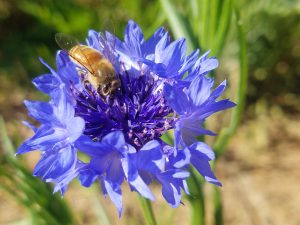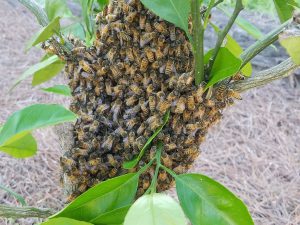
A worker bee gathering nectar and pollen.
As the weather warms, it seems that all kinds of living things start stirring. From birds to bees, plants to ants, and gnats to tourists, the world comes alive in the spring. It’s those bees we’ll discuss here, because every year they swarm, and that can cause some consternation among the homeowners whose houses they invade.
Honeybees are vitally important to our wellbeing, as they act as pollinators for many of our crops. They supply us with honey and wax and are a source of livelihood for many individuals. Important though they may be, they can sometimes become a nuisance.
Honeybees are eusocial organisms. Each honeybee lives in a colony or hive that it cannot survive without. In fact, it can be helpful to think of the entire hive as a single organism, even if it is made up of many individuals. The queen bee is the only one who lays eggs, but she cannot forage for her own food. Workers supply pollen and nectar to the hive but cannot reproduce on their own. Drones, or male bees, exist only to mate and would quickly die without the support of their sisters.
When a queen reproduces, she lays eggs that develop into new workers. When the time is right, she may lay eggs that develop into drones, or new females may be fed a substance called royal jelly that causes them to develop into new queens. These new drones and queens are born in preparation for a new hive to be created rather than to add more bees to the existing one. The old queen will be the adventurous one, so the workers put her on a diet. Once she has lost weight (to make it easier for her to fly), she takes half the workers in the hive and goes out in search of a new place to live. One of the new queens, after mating, returns to the nest and prepares to continue the work of her predecessor.
When the old queen leaves with her coterie, this is called a swarm. When weather warms and nectar begins to flow, the

A swarm of bees looking for a new home.
bees travel from place to place looking for a good spot to live. Hollow cavities in trees are a favorite spot, but bee scouts often find what they think are perfect living places in our homes or sheds. While they are searching for a new place to set up shop, they may rest on trees or branches in large clumps. Do not be alarmed if you see one, as it does not mean they are nesting where they’ve stopped. Wait a while to see if they leave on their own or contact a local beekeeper to see if they want to collect the swarm.
If bees have taken up residence somewhere they’re not welcome, there are companies and individuals who may be able to collect the bees rather than destroying them. If removal is not an option, nuisance bees may be eradicated under Florida law, but this must be done by a certified Pest Control Operator.
If you have a swarm or hive on your property, check with the Department of Agriculture (Bee Removal or Eradication in Florida Resources) to find information and for a list of bee removal specialists. See our EDIS publication on choosing a pest control operator at Choosing the Right Pest Control Operator for Honey Bee Removal: A Consumer Guide. You can also contact your local Extension office for help with finding someone local.
- The Eastern Lubber Grasshopper - June 5, 2025
- Grass is Growing; Time for Mowing - April 30, 2025
- Variegation, Viruses, and You - June 27, 2024
